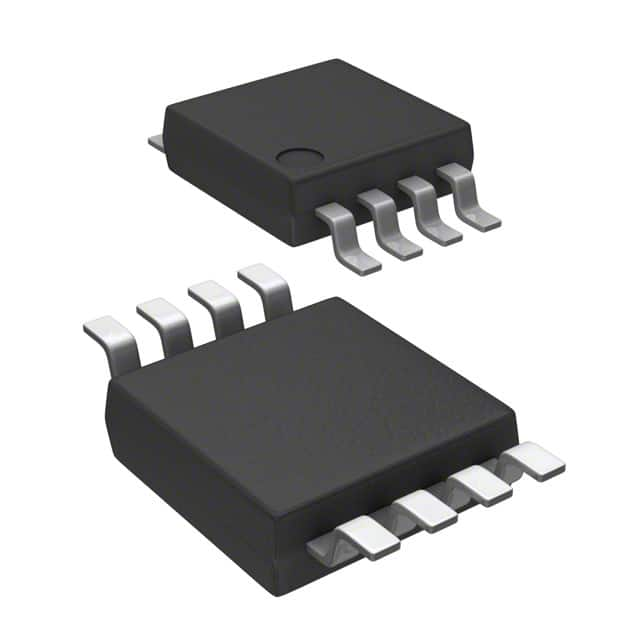Viz Specifikace pro podrobnosti o produktu.

Encyclopedia Entry: 93C66B-I/MS
Product Overview
- Category: Integrated Circuit (IC)
- Use: Non-volatile Electrically Erasable Programmable Read-Only Memory (EEPROM)
- Characteristics: Small form factor, low power consumption, high data retention, and easy integration
- Package: MSOP-8 (Mini Small Outline Package)
- Essence: The 93C66B-I/MS is a versatile EEPROM IC that provides non-volatile memory storage for various electronic devices.
- Packaging/Quantity: Available in tape and reel packaging with 2500 units per reel.
Specifications
The 93C66B-I/MS has the following specifications: - Memory Size: 4 Kbits (512 x 8 bits) - Operating Voltage: 2.5V to 5.5V - Operating Temperature Range: -40°C to +85°C - Write Time: 5 ms (typical) - Data Retention: 200 years (minimum)
Detailed Pin Configuration
The 93C66B-I/MS features an 8-pin Mini Small Outline Package (MSOP-8) with the following pin configuration:
| Pin Number | Pin Name | Function | |------------|----------|----------| | 1 | CS | Chip Select | | 2 | SK | Serial Clock Input | | 3 | DI | Serial Data Input | | 4 | VSS | Ground | | 5 | DO | Serial Data Output | | 6 | NC | No Connection | | 7 | NC | No Connection | | 8 | VCC | Power Supply |
Functional Features
- Serial Interface: The 93C66B-I/MS communicates using a simple three-wire serial interface, making it easy to integrate into various systems.
- Non-volatile Memory: The IC retains data even when power is disconnected, ensuring data integrity and reliability.
- Electrically Erasable: The EEPROM allows for easy erasure and reprogramming of data, providing flexibility in data storage.
- High Data Retention: The 93C66B-I/MS offers a minimum data retention period of 200 years, ensuring long-term data preservation.
Advantages and Disadvantages
Advantages: - Compact size enables integration into space-constrained devices. - Low power consumption prolongs battery life in portable applications. - Easy-to-use serial interface simplifies system integration. - High data retention ensures long-term reliability.
Disadvantages: - Limited memory capacity (4 Kbits) may not be sufficient for certain applications requiring larger storage. - Relatively slower write time compared to some other EEPROM models.
Working Principles
The 93C66B-I/MS utilizes an electrically erasable technology to store and retrieve data. It consists of a matrix of memory cells that can be individually programmed or erased using electrical signals. The serial interface allows for sequential reading and writing of data, making it suitable for applications where frequent data updates are required.
Detailed Application Field Plans
The 93C66B-I/MS finds application in various electronic devices, including but not limited to: 1. Automotive electronics: Used for storing vehicle configuration settings, mileage data, and diagnostic information. 2. Consumer electronics: Integrated into smart TVs, set-top boxes, and home appliances for storing user preferences and firmware updates. 3. Industrial automation: Employed in programmable logic controllers (PLCs), sensors, and control systems for data logging and parameter storage. 4. Medical devices: Utilized for storing patient data, device configurations, and calibration information in medical equipment.
Detailed and Complete Alternative Models
- 93C46B-I/MS: Similar to the 93C66B-I/MS, but with a smaller memory capacity of 1 Kbit.
- 93C86B-I/MS: Offers a larger memory capacity of 16 Kbits, suitable for applications requiring more storage space.
- 25AA040-I/MS: A SPI-compatible EEPROM IC with a memory size of 4 Kbits, offering an alternative interface option.
In conclusion, the 93C66B-I/MS is a versatile EEPROM IC that provides non-volatile memory storage in a compact form factor. With its easy integration, high data retention, and various application possibilities, it serves as a reliable solution for storing critical data in electronic devices across different industries.
Word Count: 530
Seznam 10 běžných otázek a odpovědí souvisejících s aplikací 93C66B-I/MS v technických řešeních
What is the operating voltage range of 93C66B-I/MS?
- The operating voltage range of 93C66B-I/MS is 2.5V to 5.5V.What is the maximum clock frequency supported by 93C66B-I/MS?
- The maximum clock frequency supported by 93C66B-I/MS is 3MHz.Can 93C66B-I/MS be used in automotive applications?
- Yes, 93C66B-I/MS is suitable for automotive applications.What is the typical write cycle time for 93C66B-I/MS?
- The typical write cycle time for 93C66B-I/MS is 10ms.Is 93C66B-I/MS compatible with SPI interface?
- Yes, 93C66B-I/MS is compatible with SPI interface.What is the temperature range for 93C66B-I/MS?
- The temperature range for 93C66B-I/MS is -40°C to 125°C.Can 93C66B-I/MS be used in industrial control systems?
- Yes, 93C66B-I/MS is suitable for use in industrial control systems.What is the package type of 93C66B-I/MS?
- 93C66B-I/MS is available in an 8-pin SOIC package.Does 93C66B-I/MS support partial page writes?
- No, 93C66B-I/MS does not support partial page writes.Is 93C66B-I/MS RoHS compliant?
- Yes, 93C66B-I/MS is RoHS compliant.

